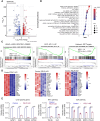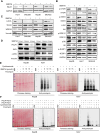PELP1 Is a Novel Therapeutic Target in Hepatocellular Carcinoma
- PMID: 39258975
- PMCID: PMC11456993
- DOI: 10.1158/2767-9764.CRC-24-0173
PELP1 Is a Novel Therapeutic Target in Hepatocellular Carcinoma
Abstract
Hepatocellular carcinoma (HCC) is one of the leading causes of cancer-related deaths in the United States, with a median survival period of approximately 10 months. There is an urgent need for the development of effective targeted therapies for the treatment of HCC. Proline-, glutamic acid-, and leucine-rich protein 1 (PELP1) signaling is implicated in the progression of many cancers, although its specific contribution to the progression of HCC is not yet well understood. Analysis of The Cancer Genome Atlas HCC gene expression data sets and IHC analysis of HCC tissue microarray revealed that HCC tumors had elevated expression of PELP1 compared with normal tissues, and high expression of PELP1 is associated with unfavorable survival outcomes. Suppression of PELP1 expression using short hairpin RNA significantly reduced the cell viability, clonogenicity, and invasion of HCC cells. Importantly, SMIP34, a first-in-class small-molecule inhibitor targeting PELP1, effectively decreased the cell viability, clonogenic survival, and invasiveness of HCC cells. Gene expression analysis using RNA sequencing revealed that PELP1 knockdown cells exhibited a decrease in c-Myc, E2F, and other oncogenic pathways related to HCC. Mechanistic studies showed that SMIP34 treatment impaired the Rix complex, a critical component of ribosomal biogenesis, in HCC cells. Furthermore, the knockdown or pharmacologic inhibition of PELP1 significantly decelerated the HCC tumor growth in xenograft models. In summary, our study findings indicate that PELP1 could serve as a promising target for therapeutic intervention in HCC.
Significance: HCC is one of the leading causes of cancer fatalities in the United States. Effective targeted therapeutics for HCC are urgently needed. In this study, we show that PELP1 proto-oncogene is crucial to HCC progression and that PELP1 inhibition reduced HCC cell proliferation in vitro and in vivo. Our results imply that PELP1-targeted drugs like SMIP34 may be useful as new therapeutic agents for HCC treatment.
©2024 The Authors; Published by the American Association for Cancer Research.
Conflict of interest statement
L.-Z. Sun reports grants from the NIH, grants from Clayton Foundation for Research, and University of Texas Health San Antonio during the conduct of the study. No disclosures were reported by the other authors.
Figures





References
-
- Sung H, Ferlay J, Siegel RL, Laversanne M, Soerjomataram I, Jemal A, et al. . Global cancer statistics 2020: GLOBOCAN estimates of incidence and mortality worldwide for 36 cancers in 185 countries. CA Cancer J Clin 2021;71:209–49. - PubMed
-
- Llovet JM, Kelley RK, Villanueva A, Singal AG, Pikarsky E, Roayaie S, et al. . Hepatocellular carcinoma. Nat Rev Dis Primers 2021;7:6. - PubMed
Publication types
MeSH terms
Substances
Grants and funding
LinkOut - more resources
Full Text Sources
Medical
Molecular Biology Databases
Research Materials
Miscellaneous

